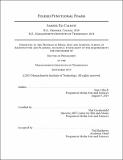Folded functional foams
Author(s)
Calisch, Samuel Eli.
Download1203143203-MIT.pdf (33.92Mb)
Other Contributors
Program in Media Arts and Sciences (Massachusetts Institute of Technology)
Advisor
Neil Gershenfeld.
Terms of use
Metadata
Show full item recordAbstract
Materials with effective properties dominated by geometric structure rather than composition, or architected materials, are used in nature and engineering to maximize performance subject to constraints of mass and energy. Conventional engineering examples have included textiles, polymer and metal foams, and honeycombs, but developments in digital fabrication have vastly expanded the field. The majority of this new work has focused on 3D printing for its high degree of geometric control, though production rates have been slow, material properties poor, and manufacturing costs high. An alternative, growing body of work has developed around structural origami and kirigami, where planar sheets are processed and folded to create three-dimensional architected materials. This work aims to leverage planar fabrication for scalable manufacturing, on-demand customization, and low embodied energy while exploiting the geometric richness of origami to tailor shape and maximize mechanical performance. This thesis seeks to demonstrate the engineering potential of folded architected materials by showing scalability through automated production, structural control of three-dimensional shape and stiffness, and functional control of energy transduction. We first show a custom machine for automating cutting and folding of shaped honeycombs, illustrating the capability to prescribe large-scale geometry of an architected material in a continuous production process. We then modify this construction to make shaped architected materials with prescribed stiffness, producing shoe soles as a demonstration. Finally, we show three forms of energy transduction in folded architected materials -- reflection, absorption, and transmission -- and apply each to a relevant, difficult engineering problem. For energy reflection, we maximize the ratio of strain energy output to input in a collision event, taking running shoe soles as a test case and comparing performance to conventional polymer foams. For energy absorption, we maximize total energy absorbed per unit mass and apply this to vehicular crashboxes, comparing the results to aluminum honeycombs. For energy transmission, we use energy input to drive deformation modes with desired output force and geometry, taking as an application the generation of traveling waves on a hydrofoil surface (a longstanding goal of active flow control), evaluating viability under tow tank testing.
Description
This electronic version was submitted by the student author. The certified thesis is available in the Institute Archives and Special Collections. Thesis: Ph. D., Massachusetts Institute of Technology, School of Architecture and Planning, Program in Media Arts and Sciences, September, 2019 Cataloged from student-submitted PDF of thesis. Includes bibliographical references (pages 117-135).
Date issued
2019Department
Program in Media Arts and Sciences (Massachusetts Institute of Technology)Publisher
Massachusetts Institute of Technology
Keywords
Program in Media Arts and Sciences